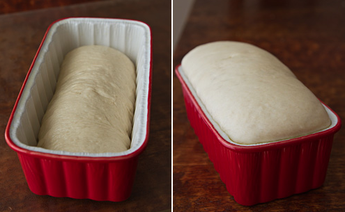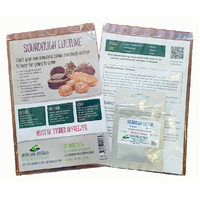Bread Making Instructions

Useful Tips
You can use any type flour when making sourdough but for the best outcome, I recommend using the best quality, organically grown flour you can get, preferably freshly ground if possible.
Use filtered water (to get any chlorine out of tap water).
Always allow your culture to come to room temperature before opening and handling, and keep closed as much as possible.
Sourdough Directions
Essentially sourdough starter is a mixture of flour and water, rich in bacteria and yeast, either added or naturally occurring from the environment, that is used to make sourdough bread.. Most bread cultures are used to control the indigenous bacteria naturally present in the flour, which might produce unwanted characteristics such as excessive sourness or a spoiled taste. Adding the cultures will ensure a uniform and more complex flavour development with minimal batch-to-batch variations.
The variety of flour used influences the characteristics of the sourdough and it is possible to make sourdough with wheat, rye and other types or mixtures of flours. Other important parameters influencing the attributes of the cultures are time and temperature during the processing. Additionally, it is possible to produce sourdough adding milk, oils, sugar and salt, which also will influence the result.
Making Your Sourdough Starter (pre-dough or mother).
First, you have to make up your sourdough starter, using flour, water and bacteria. In some cases, you may also add some sugar and/or salt, which will affect the flavour of your final bread. Please see directions for full details on how to do this step. Once you have made your starter you are ready to take a portion of this starter and make your bread, following the recipe of your choice. The remaining starter can be stored in your fridge for later use.
Making your starter: (Small batch)
Step 1. Preparing the initial pre-dough.
- Mix 500 grams of flour with 500 ml of water (one part flour to one part water) to make one kg of pre-dough.
- Add 0.25 grams, or one pinch if using our mini measuring spoons, of the starter culture. The starter culture can be dispersed in a small amount of water and then be added to the flour, mixing in well.
- Cover with a wet tea towel and allow to rest. Depending on the required effect (acidity and flavour development) and type of flour, the resting time for the wheat pre-dough should be up to 24 hours at 20-30°C. At 25°C, 12-18 hours are recommended whereas at 20°C the time should be increased. For pure rye pre-dough it is recommended that the resting time should be more than 24 hours at above 37°C. The shorter the resting time the less sourness (acid production) and flavour components are developed. The dough should be stirred from time to time.

The second step is to feed it
Step 2. Feeding the Mother.
- Discard 500 grams (half) of the mother. This discarded mother can be used to make your bread.
- Mix 250 grams of flour with 250 ml of water.
- Take your now 500 gram Mother and blend this with your new mixture of flour and water giving you one kg.
- Cover and leave at room temperature or pop it in the fridge. In the fridge, you will need to discard and feed once a week. Out of the fridge you will need to discharge and feed event day.
This can be scaled down if not planning to make lots of sourdough at a time.
Now you have the discarded sourdough mother you are ready to make bread using this as your leaven.
Preparation of the bread
- Following your bread recipe, add the required amount of sourdough mother (leaven) to your other ingredients. My discard is always 500 grams so I always make bread or pancakes using 500 grams of mother. Allow to rise for the required amount of time in your recipe, or for sufficient time to get the rise you are looking for.

I have used this sourdough mother (leaven) to make breads with or without additional bakers yeast with good results. The addition of bakers yeast speeds up the rising process. Without the yeast I like to let my bread rise 12 to 24 hours, depending on the flour I am using. Rye flour always takes longer to rise. Slow fermentation bread is also easier to digest as the gluten and other difficult-to-digest proteins are partially broken down during the fermentation process. This may explain why many people who are gluten intolerant can eat sourdough bread with little or no negative effects.
We hope you enjoy our our explainer Video Instructions.

